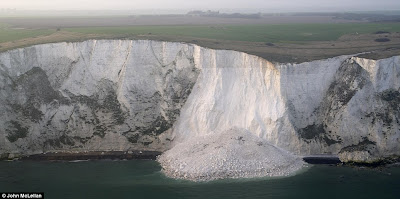Stretching across Dover's eight mile coastline and reaching 350 feet heights, the White Cliffs of Dover's coastal landscape formed during the Cretaceous period as sea floor spreading and uplift along the mid-Atlantic ridge, along with subsiding sea levels during successive ice ages, formed the Cliffs seen today. Crushed and fossilized sea creatures make up the chalk limestone rock as frost weathering, along with possible root pressure, keep the Cliffs white as chunks from the Cliffs break off exposing newer and previously covered chalk.
The Cliffs' erosional landform results from stormy winter weather and sea waves undermining the Cliffs. Under the sea millions of years ago and slowly eroding today, Dover's White Cliffs stand erect looking across the English Channel, but what does the future hold for the Cliffs? I will spend the remainder of my blog hypothesizing what the White Cliffs of Dover will look like 1,000, 10,000, and 1,000,000 years from now.
THE WHITE CLIFFS OF DOVER 1,000 YEARS FROM NOW
One source reports Dover's Cliffs erode approximately one to two inches each year, which will not dramatically change the Cliffs over the next 1,000 years.
 |
| (The Cliffs will erode only slightly over the next 1,000 years and not much will change because much land, pictured above, stretches across and behind the Cliffs. http://www.ego4u.com/en/read-on/countries/uk/tour/dover) |
I surmise erosion and cliff collapses will continue over the next 1,000 years due to frequent and recent collapses in 2001 and 2012. Frost weathering each winter and root pressure from Cliff vegetation, along with constant sea undermining, will help erode the Cliffs in the future just as they have for millions of years.
 | ||
| (During stormy winters, water absorbed by the Cliffs' ground freezes and exerts force, causing rock to crumble and fall and collapse. http://noahmcdermottgeog1202fall12.blogspot.com/search?updated-min=2012-01-01T00:00:00-07:00&updated-max=2013-01-01T00:00:00-07:00&max-results=4)
|
THE WHITE CLIFFS OF DOVER 10,000 YEARS FROM NOW
Another nine thousand years of weathering will have similar and little impact just as 1,000 years from now will. If the Cliffs continue eroding one to two inches each year only 277.7778 to 555.55556 yards of land will be lost in the next 10,000 years. Similar to 1,000 years from now frost weathering, root pressure, and sea wave impact will cause the White Cliffs to erode less than one mile inland in the next 10,000 years over Dover, England's vast landscape.
(The RED lines and end points represent how much land will be lost in 10,000 years: approximately 0.25 to 0.50 kilometres or approximately, and just under, one third of one mile. Dover and the Cliffs will be impacted but not much in 10,000 years.
THE WHITE CLIFFS OF DOVER 1,000,000 YEARS IN THE FUTURE
The White Cliffs of Dover will face bigger changes 1,000,000 years in the future than 1,000 and 10,000 years from now, but not drastic changes. Up to approximately 31.57 miles of Dover and southeast England will erode inland from the current spot of the Cliffs in 1,000,000 years.
(The BLUE lines represent how far in the Cliffs will recede if they erode one inch each year and the RED line represents how far northwest the Cliffs will move if they erode two inches per year. The change is rather significant and much of southeast England will be eroded 1,000,000 years from now.
Although the Cliffs will see significant land loss, the land's form will not change over the next 1,000,000 years. The Cliffs will only have passed west of current Canterbury, and as all of southeast England's soil northwest of Dover is comprised of chalk, the Cliff's coastline will remain chalk.
(Chalk represented by the GREEN bricks extends northwest from Dover and west of Canterbury for miles. The RED line represents where the Cliffs will be approximately 1,000,000 years in the future, just past Canterbury, with much chalk left extending northwest.
Google Images Search: link not available
Links Confirming Data on Graphic:
1,000,000 years from now seems like a long time, but in the grand scheme of Earth's geographical history it is not. Much of Dover's land will recede in 1,000,000 years' time just as in the last 1,000,000 years new land formed and older land eroded.
Sources:
- http://www.bbc.co.uk/england/sevenwonders/southeast/white_cliffs/
- http://www.whitecliffscountryside.org.uk/index.php?id_sec=1&id_sub=1
- http://blogs.redorbit.com/the-white-cliffs-of-dover/
- http://oceana.org/en/explore/marine-places/white-cliffs-of-dover
- http://noahmcdermottgeog1202fall12.blogspot.com/search?updated-min=2012-01-01T00:00:00-07:00&updated-max=2013-01-01T00:00:00-07:00&max-results=4
- http://clasfaculty.ucdenver.edu/callen/1202/Landscapes/KarCoast/KarCoast.html























